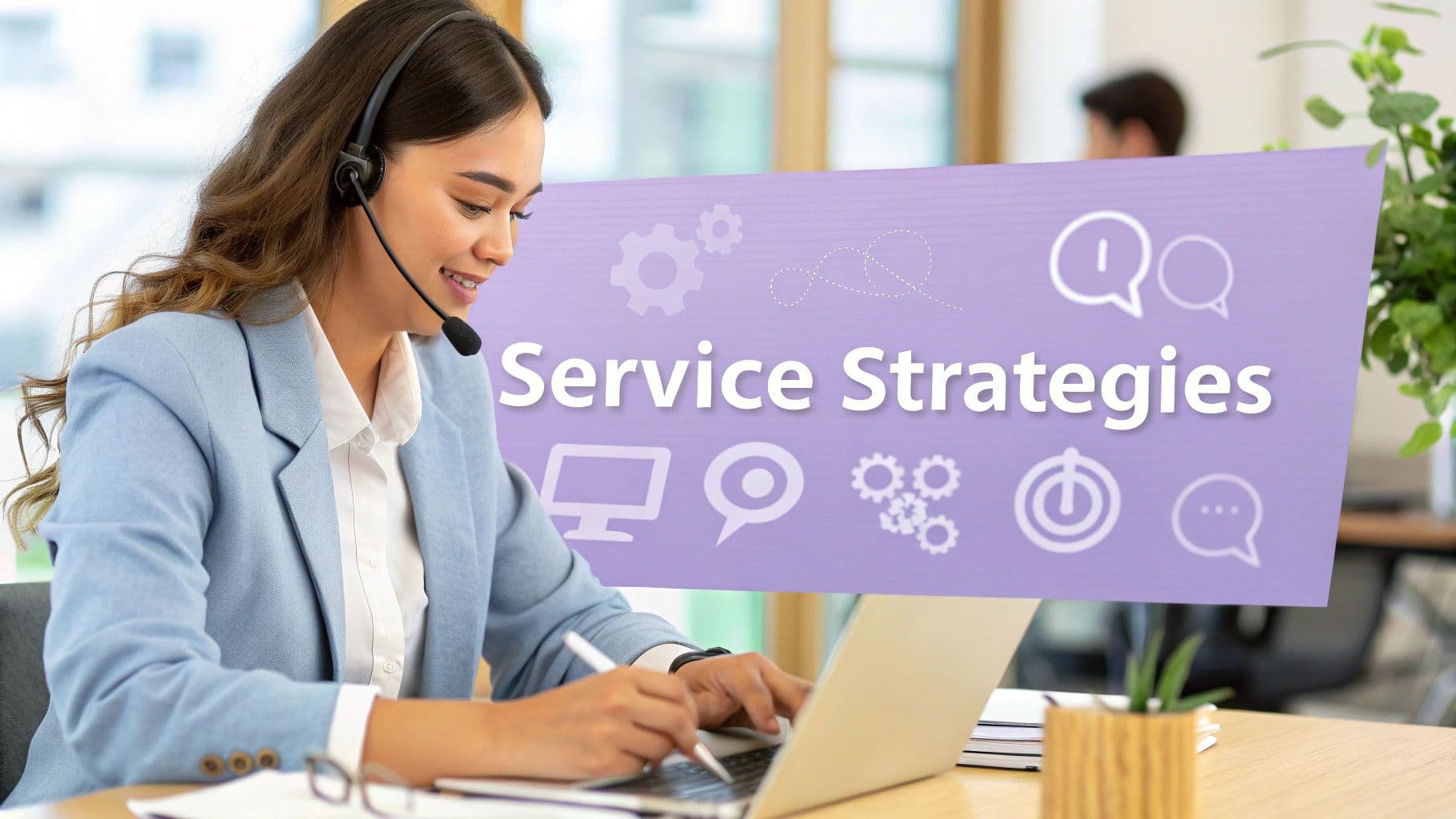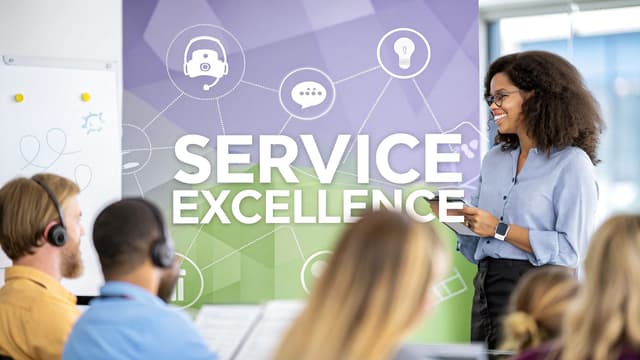In today's competitive market, generic advice no longer cuts it. Customer expectations have evolved, demanding more than just prompt replies; they seek personalized, proactive, and seamless experiences. This article moves beyond the clichés to provide a definitive guide to the essential best practices for customer service teams must adopt. We will break down nine critical strategies, providing actionable steps, real-world examples from industry leaders, and practical guidance on how to implement them.
This isn't just about theory. We will explore how intelligent tools like FlowGent AI can automate and enhance these practices, allowing your team to focus on building genuine customer loyalty and driving business growth. For a deeper dive into modern approaches that move beyond traditional mindsets, explore these Top Customer Service Improvement Strategies for 2025. Get ready to transform your support from a cost center into a powerful revenue driver by implementing a framework built for modern customer needs. This guide will show you precisely how to deliver service that not only satisfies but also retains customers for the long term.
1. Master Active Listening and Empathy
Active listening is a cornerstone of exceptional customer service, demanding complete concentration on what the customer is communicating, both verbally and non-verbally. It's about understanding the core issue, not just hearing the words. When combined with empathy, the ability to genuinely connect with the customer's emotional state, this practice transforms a potentially frustrating interaction into a supportive, relational experience. This approach ensures customers feel truly heard and valued, building a foundation of trust essential for loyalty.

This principle is fundamental because it directly addresses the customer's primary need: to be understood. When agents practice active listening and empathy, they can de-escalate tense situations, uncover the root cause of a problem more quickly, and provide solutions that resonate on a personal level.
Real-World Success Stories
Many leading brands have built their reputation on this very principle. Zappos, famously led by Tony Hsieh, empowered its support team to build emotional connections, famously abandoning call-time metrics. Similarly, Ritz-Carlton authorizes its staff to spend up to $2,000 per guest to resolve an issue, a policy that trusts employees to use empathy to create legendary service moments.
Actionable Tips for Implementation
To integrate this into your operations, focus on practical training and system-level support:
- Paraphrase and Clarify: Train agents to repeat the customer's issue in their own words (e.g., "So, if I understand correctly, the package arrived damaged, and you need a replacement sent out immediately?"). This confirms understanding and shows the customer they are being heard.
- Use Empathetic Language: Incorporate phrases that validate feelings, such as "I can understand how frustrating that must be," or "I'm so sorry to hear you've had this experience."
- Implement Scenario Training: Use regular role-playing sessions to help your team practice navigating difficult conversations and responding with empathy in a controlled environment.
2. Omnichannel Customer Experience
An omnichannel customer experience provides a seamless and integrated journey across all customer touchpoints, including phone, email, social media, and in-person interactions. This approach ensures that customer data and conversation history move with the customer, creating a single, unified brand experience. This allows customers to switch between channels, like from a web chat to a phone call, without ever having to repeat information or start their query from scratch.

This practice is one of the most vital best practices for customer service because it eliminates friction and meets modern customer expectations for convenience. By breaking down silos between departments and channels, you create a cohesive journey that respects the customer's time and effort, significantly boosting satisfaction and loyalty.
Real-World Success Stories
Pioneers like Amazon, largely shaped by Jeff Bezos's customer-centric vision, have perfected this model. A customer can browse on their laptop, add an item to their cart via the mobile app, and ask Alexa for a delivery update, all within one seamless ecosystem. Similarly, Starbucks, under Howard Schultz, integrated its mobile app with its in-store experience, allowing customers to order, pay, and earn rewards effortlessly across digital and physical realms.
Actionable Tips for Implementation
Deploying a true omnichannel strategy requires careful planning and the right technology:
- Map the Customer Journey: Begin by comprehensively mapping all potential touchpoints a customer has with your brand. Identify where customers switch channels and where friction currently exists.
- Invest in a Unified Platform: Use a robust CRM or a customer service platform that can centralize data from all channels. This integration is the technical backbone of an omnichannel experience.
- Train for Consistency: Ensure your support teams are trained to deliver a consistent brand voice and service standard, regardless of the channel they manage.
- Analyze and Optimize: Use analytics to monitor performance across channels. Identify and resolve bottlenecks to continuously improve the customer flow. Learn more about how to set up an effective omnichannel customer service strategy.
3. Proactive Customer Service
Proactive customer service involves anticipating customer needs and addressing potential issues before they become significant problems. This forward-thinking strategy shifts the support model from reactive problem-solving to preventive care. By leveraging data analytics, customer behavior patterns, and predictive modeling, businesses can identify opportunities for timely intervention, turning potential friction into a smooth, positive experience that builds brand affinity.

This principle is one of the most impactful best practices customer service teams can adopt because it demonstrates a deep commitment to the customer's success. The future of modern service lies in anticipating customer needs rather than merely reacting. This requires a fundamental shift to understanding and implementing strategies for proactive customer service, which ultimately reduces support tickets, minimizes customer frustration, and fosters loyalty by solving problems before they are even noticed.
Real-World Success Stories
Innovators like Reed Hastings at Netflix have perfected this approach. Netflix often sends notifications about streaming issues in a user's area before the user even opens the app. Similarly, HubSpot, co-founded by Brian Halligan, uses customer health scores to monitor user engagement, allowing its success teams to reach out with helpful resources if they detect a drop in activity, preventing churn.
Actionable Tips for Implementation
To integrate this practice, focus on using data and automation to get ahead of customer challenges:
- Implement Monitoring Systems: Use robust analytics tools to track customer behavior, product usage, and potential technical glitches. Set up alerts for early warning signs of trouble, such as failed payments or repeated error messages.
- Create Automated Workflows: Design automated outreach for common proactive scenarios. For example, send an automated email with shipping updates if a logistics delay is detected or a tutorial video if a user is struggling with a new feature.
- Segment and Personalize: Group customers based on their behavior, lifecycle stage, or purchase history to send highly relevant, preemptive communications that add value instead of feeling like spam.
4. Employee Empowerment and Training
Empowering employees means giving your frontline staff the authority, tools, and confidence to resolve customer issues without navigating restrictive approval chains. This autonomy, supported by robust training in both technical and soft skills, allows agents to deliver swift, decisive, and personalized resolutions. When employees are trusted to make decisions, they transform from script-followers into genuine problem-solvers, dramatically improving the customer experience and fostering a culture of ownership.

This practice is essential because it directly removes friction from the resolution process. An empowered agent can solve a problem on the first contact, preventing escalation and customer frustration. This approach to customer service not only enhances efficiency but also boosts employee morale and retention, as team members feel valued and trusted in their roles.
Real-World Success Stories
This principle is famously embodied by companies known for legendary service. The Ritz-Carlton authorizes every employee to spend up to $2,000 per guest to resolve an issue, a policy that showcases ultimate trust. Southwest Airlines has long championed an employee-first philosophy under Herb Kelleher, believing that happy, empowered employees naturally lead to satisfied customers. Similarly, Zappos built its brand on agent autonomy, encouraging unscripted, human-centric conversations.
Actionable Tips for Implementation
To build an empowered team, you need a framework of trust and clear guidance:
- Establish Clear Guidelines: Define the boundaries of empowerment. Set clear spending limits or decision-making authority so employees know exactly what they can do without seeking approval.
- Invest in Continuous Training: Implement comprehensive onboarding that covers products, policies, and soft skills like negotiation and de-escalation. Follow up with regular training to keep skills sharp and knowledge current.
- Foster a Supportive Culture: Encourage calculated risk-taking and assure your team that you will support their decisions. Frame mistakes as learning opportunities, not punishable offenses, to build confidence.
5. Personalized Customer Interactions
Personalized customer interactions involve using customer data and history to create tailored experiences that feel individual and relevant. This practice goes beyond simply using a customer's name; it means understanding their past purchases, preferences, and previous support issues to anticipate their needs. When executed well, personalization transforms a standard transaction into a unique, memorable engagement, fostering a strong emotional connection that drives satisfaction and long-term loyalty.
This principle is one of the most powerful best practices in customer service because it shows customers that they are seen as individuals, not just account numbers. By acknowledging their history and preferences, you demonstrate genuine care and make them feel valued, significantly increasing the chances they will remain loyal to your brand.
Real-World Success Stories
Tech and retail giants have pioneered this approach. Amazon, under Jeff Bezos, built an empire on personalized product recommendations and a support system that has instant access to a customer's entire order history. Similarly, Netflix's success is heavily driven by its algorithm that provides customized content suggestions, creating a highly personal user experience that keeps subscribers engaged.
Actionable Tips for Implementation
Integrating personalization requires a strategic approach to data and agent training:
- Implement a Robust CRM: Use a Customer Relationship Management (CRM) system to centralize and track all customer data, including purchase history, past interactions, and preferences. This gives agents a 360-degree view of the customer.
- Segment Your Customers: Group customers based on behavior, purchase history, or needs. This allows you to create targeted and more relevant service approaches for different segments.
- Train for Recognition: Empower agents to use the data available to them. Train them to reference past issues or purchases (e.g., "I see you recently bought our X-model printer, are you calling about setting that up?").
6. Rapid Response and Resolution
Rapid response and resolution focuses on minimizing the time between a customer's initial contact and the final solution to their issue. This practice prioritizes speed and efficiency, involving streamlined processes, optimized resource allocation, and efficient workflows to deliver quick, effective support. It's about respecting the customer's time and demonstrating a commitment to solving their problems without unnecessary delay, a key component of best practices customer service.
This principle is crucial because, in today's fast-paced world, customers expect immediate attention. A swift response acknowledges the customer's importance, while a fast resolution prevents frustration from escalating. This approach directly impacts customer satisfaction and can be a significant competitive differentiator, turning a potentially negative experience into a positive one.
Real-World Success Stories
Many industry leaders have built their brand on speed. Zappos, under Tony Hsieh, famously aimed to answer every call within three rings, setting a high bar for responsiveness. Buffer, led by Joel Gascoigne, champions transparency with a public dashboard displaying its real-time response metrics. Similarly, Apple’s Genius Bar model is built around providing efficient, often same-day, technical resolutions.
Actionable Tips for Implementation
To improve your speed and efficiency, focus on system-wide enhancements and targeted training:
- Set and Communicate Targets: Establish clear internal goals for first response and total resolution times (e.g., respond to all emails within one hour). Communicate these standards to customers where appropriate to manage expectations.
- Implement Smart Routing: Use systems to automatically route inquiries to the correct department or agent with the right expertise. Create clear escalation paths for complex issues to avoid bottlenecks.
- Leverage customer support automation: Deploy AI chatbots like FlowGent to handle routine, high-volume queries instantly. This frees up human agents to focus on more complex problem-solving, dramatically improving overall response times.
- Monitor and Optimize: Continuously track key performance indicators (KPIs) like First Contact Resolution (FCR) and Average Handling Time (AHT). Use this data to identify process inefficiencies and make targeted improvements.
7. Continuous Feedback Collection and Action
Continuous feedback collection is the practice of systematically gathering customer input across multiple touchpoints and then, crucially, using that data to drive meaningful improvements. It goes beyond a one-off survey, creating a dynamic loop where customer insights directly inform product development, service protocols, and the overall experience. By actively soliciting and acting upon feedback, businesses can identify blind spots, address pain points before they escalate, and make data-driven decisions that align perfectly with customer expectations. This is one of the most vital best practices in customer service for ensuring long-term relevance and loyalty.

This principle is essential because it transforms customer service from a reactive cost center into a proactive engine for growth. Organizations that consistently listen and adapt demonstrate that they value their customers' opinions, fostering a stronger, more collaborative relationship. This process uncovers specific, actionable insights that lead to higher satisfaction, reduced churn, and a superior competitive advantage.
Real-World Success Stories
This model has been masterfully executed by several tech giants. Uber’s post-ride rating system provides immediate, granular feedback that directly impacts driver quality and app functionality. Similarly, Airbnb’s dual-sided review system for hosts and guests creates a transparent, self-regulating community built on trust and continuous improvement. Microsoft, under Satya Nadella, revitalized its customer focus by heavily relying on user feedback platforms to guide product updates and innovations.
Actionable Tips for Implementation
To build a robust feedback loop, focus on systematic collection and transparent action:
- Utilize Multiple Channels: Deploy a mix of feedback tools, including post-interaction surveys (NPS, CSAT), social media listening, and direct feedback forms, to capture a comprehensive view of the customer experience.
- Automate Feedback Triggers: Use your CRM or platforms like FlowGent AI to automatically request feedback at key moments, such as after a purchase, support ticket resolution, or trial completion.
- Close the Loop: Make it a priority to communicate back to customers whose feedback led to a change. A simple email saying, "Thanks to your suggestion, we've now implemented..." can create powerful brand advocates.
8. Empower Customers with Self-Service and Knowledge Management
Self-service empowers customers to find answers and resolve issues on their own time, without needing to contact a support agent. This involves creating a comprehensive, easily accessible knowledge base filled with resources like FAQs, how-to guides, video tutorials, and community forums. When done right, it enhances the customer experience by providing instant solutions and frees up your support team to handle more complex, high-value interactions. This approach is a cornerstone of modern, scalable customer service.
This practice is essential because today's customers expect immediate access to information. An effective self-service portal not only meets this demand but also significantly reduces support ticket volume and operational costs. It turns your website into a 24/7 support resource, improving customer satisfaction and loyalty by giving them control and convenience.
Real-World Success Stories
Tech giants have mastered this approach. Atlassian, co-founded by Mike Cannon-Brookes, has built an empire on its extensive documentation and community support, allowing users to solve complex issues collaboratively. Similarly, Salesforce's Trailhead platform gamifies learning, turning product education into an engaging self-service experience. Zendesk's Guide platform is another prime example, built specifically to help companies create and manage their own powerful knowledge bases.
Actionable Tips for Implementation
To build an effective self-service hub, you must be strategic and customer-focused:
- Analyze Support Tickets: Regularly review your support inquiries to identify the most common questions and problems. Use this data to prioritize content creation for your knowledge base.
- Optimize for Search: Implement a powerful, intuitive search function. Use clear language and visual aids like screenshots and videos to make articles easy to understand and follow.
- Keep Content Fresh: Your products and services evolve, and so should your documentation. Establish a process for regularly updating content to ensure accuracy and relevance. Implementing the best practices for knowledge management ensures your resources remain valuable.
- Monitor Usage: Track analytics to see which articles are most popular and which search terms yield no results. Use these insights to fill content gaps and optimize your existing resources. A well-maintained help desk knowledge base can become your most valuable support asset.
9. Emotional Intelligence and Conflict Resolution
Emotional intelligence in customer service is the ability to recognize, understand, and manage emotions, both your own and the customer's, especially during tense interactions. This skill is critical for effective conflict resolution, allowing agents to de-escalate situations and remain professional under pressure. Mastering this practice is one of the most vital best practices customer service teams can adopt, as it transforms potentially damaging conflicts into opportunities to build even stronger customer loyalty.
This principle is essential because unresolved conflict is a primary driver of customer churn. Agents trained in emotional intelligence can navigate high-stakes conversations with poise, turning negative experiences into positive resolutions. This not only saves the customer relationship but also demonstrates a company's deep commitment to satisfaction, enhancing its reputation.
Real-World Success Stories
This approach is exemplified by companies known for exceptional service recovery. Nordstrom built its legendary reputation by empowering employees to resolve issues with immense autonomy and empathy. Similarly, JetBlue has often been praised for its proactive and humane communication during service disruptions, using emotional intelligence to manage customer frustration on a large scale.
Actionable Tips for Implementation
To build this capability within your team, focus on structured training and supportive processes:
- Implement Scenario Training: Use regular role-playing sessions that simulate difficult customer interactions. This allows agents to practice de-escalation and emotional regulation in a safe, controlled environment before facing real-world pressure.
- Develop Conflict Guidelines: Create clear scripts and guidelines for handling common conflict situations. This gives agents a solid foundation to start from, helping them feel more confident and prepared.
- Provide Employee Support: Offer debriefing sessions and support resources for employees after they handle particularly difficult interactions. Acknowledging the emotional toll is key to preventing burnout and maintaining high performance. You can learn more about how to handle customer complaints effectively with the right strategies.
Best Practices Customer Service Comparison
| Item | Implementation Complexity 🔄 | Resource Requirements ⚡ | Expected Outcomes 📊 | Ideal Use Cases 💡 | Key Advantages ⭐ |
|---|---|---|---|---|---|
| Active Listening and Empathy | Medium - requires thorough training and emotional skill | High - training time and ongoing practice | Stronger relationships, higher satisfaction | Customer-facing roles needing trust and rapport | Builds loyalty, reduces frustration, improves resolution |
| Omnichannel Customer Experience | High - complex tech integration and coordination | Very high - CRM systems, integration platforms, training | Seamless brand experience and increased customer retention | Businesses with multiple customer contact channels | Consistent experience, better data insights, loyalty |
| Proactive Customer Service | High - advanced analytics and predictive capabilities | High - investment in data systems and monitoring | Reduced issues, increased satisfaction | Companies aiming to prevent problems before they occur | Prevents problems, cost savings, improves quality |
| Employee Empowerment and Training | Medium to High - training and cultural alignment needed | High - comprehensive training and support systems | Faster resolution, higher employee and customer satisfaction | Organizations wanting agile frontline decision-making | Quicker solutions, personalized service, employee retention |
| Personalized Customer Interactions | Medium to High - requires data integration and analysis | High - CRM, data management, staff training | Increased loyalty, higher revenue, better retention | Customer-centric businesses focusing on tailored service | Enhances loyalty, boosts conversion, brand differentiation |
| Rapid Response and Resolution | Medium - process optimization and workflow refinement | Medium to High - staffing, automation tools | Faster issue resolution, higher satisfaction | High-volume support needing speed without quality loss | Competitive speed, efficiency, improved resource use |
| Continuous Feedback Collection and Action | Medium - system setup and ongoing effort | Medium to High - feedback tools and analysis teams | Ongoing experience improvement, early issue detection | Businesses committed to customer-driven improvements | Data-driven decisions, increased loyalty, issue spotting |
| Self-Service and Knowledge Management | Medium - initial content creation and platform setup | Medium - content production and maintenance | Reduced support volume, 24/7 access to solutions | Companies with frequent, repeatable customer issues | Cost-saving, scalable support, improved satisfaction |
| Emotional Intelligence and Conflict Resolution | Medium to High - intensive training and culture shift | High - training programs and ongoing coaching | Better complaint handling, higher satisfaction post-conflict | Customer service in high-stress or conflict-prone areas | De-escalates issues, enhances reputation, reduces escalations |
From Best Practices to Best-in-Class Performance
The journey through the nine pillars of exceptional customer service reveals a powerful, interconnected truth: excellence is not a single action but a comprehensive strategy. Mastering these best practices customer service principles is about weaving empathy, efficiency, and intelligence into the very fabric of your customer interactions. We've explored everything from the foundational importance of active listening and emotional intelligence to the strategic necessity of an omnichannel presence and proactive support. This isn't just about closing tickets faster; it's about building lasting relationships, one positive interaction at a time.
The shift from a reactive support model to a proactive, customer-centric ecosystem is the defining characteristic of modern market leaders. By empowering your employees, personalizing every touchpoint, and creating robust self-service options, you don’t just solve problems, you anticipate them. This strategic foresight transforms your service department from a cost center into a powerful engine for growth, customer loyalty, and brand differentiation.
Synthesizing the Core Principles
Ultimately, these best practices converge on a central theme: value.
- Value for the Customer: They feel heard, understood, and respected. Their time is valued through rapid responses and effective self-service. Their loyalty is valued through personalized and proactive engagement.
- Value for Your Team: They are empowered and equipped, not just with scripts, but with the training and tools to make autonomous, customer-first decisions. This fosters job satisfaction and reduces burnout.
- Value for the Business: Customer loyalty increases, churn decreases, and positive word-of-mouth becomes your most effective marketing tool. Operational efficiency is gained through smart automation and well-managed knowledge bases.
Your Actionable Path Forward
Translating these concepts from theory into daily practice is your next critical step. Begin by auditing your current operations against the nine practices discussed. Where are your strengths? Where are the most significant gaps? Prioritize implementing changes that will have the most immediate impact. For many, this starts with improving response times and providing consistent answers across all channels.
This is where technology becomes a strategic amplifier. Implementing a tool like FlowGent AI can automate the repetitive, time-consuming tasks that bog down your team, freeing them to focus on the complex, high-empathy interactions that truly define a premium service experience. By leveraging AI to manage initial queries, route complex issues, and provide 24/7 support, you can enact these best practices customer service strategies at scale without sacrificing the essential human touch. The goal is a harmonious blend of human skill and technological efficiency, creating a service infrastructure that is both resilient and remarkably responsive. Committing to this continuous journey of improvement is how you move from simply following best practices to setting the standard for best-in-class performance.
Ready to transform your support operations and implement these best practices with cutting-edge automation? Discover how FlowGent AI can empower your team to deliver personalized, 24/7 service across every channel, turning customer interactions into your greatest competitive advantage. Visit FlowGent AI to see how our platform can help you achieve service excellence.



